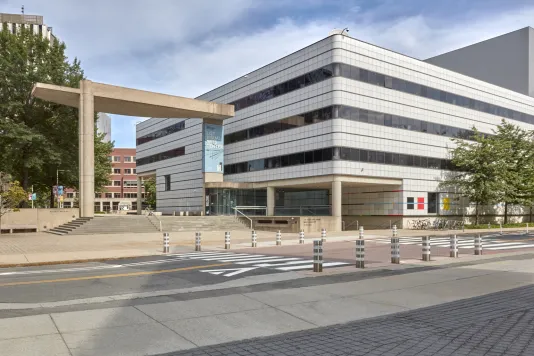I.M. Pei, Wiesner Building, 1985. Photo by Chuck Mayer Photography.

I.M. Pei, Wiesner Building, 1985. Photo by Chuck Mayer Photography.
A campus hub for the arts, the Wiesner Building (Building E15) decidedly sets itself apart from I. M. Pei’s earlier projects at MIT. The Green Building (Building 54), the Dreyfus Chemistry Building (Building 18), and the Landau Building (Building 66) all share a common language of precast concrete forms, crisp rectilinear geometries, and facades articulated by large, gridded window arrangements.
In contrast, the Wiesner Building is clad in white aluminum panels on the interior and exterior, visually offset by a series of dark-toned ribbon windows that sweep across the rounded corners of the flat-roofed structure. A concrete gateway composed of three distinct volumes boldly juts off the structure, welcoming visitors toward the idiosyncratic courtyard designed by environmental artist Richard Fleischner.
In the interior, the aluminum panels on the atrium walls are accentuated by painter Kenneth Noland's polychromatic additions between the gridlines, and the concrete staircase and gently curved balustrades and benches by sculptor Scott Burton further enhance the geometric diversity of the space. Light streams in from the glass ceiling above, filtering through the latticework supports. The collaboratively produced elements by Fleischner, Noland, and Burton are a vivid demonstration of the interdisciplinary nature of the arts space.
Ieoh Ming Pei was born in Guangzhou, China, and spent his childhood in Hong Kong and Shanghai. He received a Bachelor of Architecture from MIT in 1940 and went on to enroll in Harvard Graduate School of Design in 1942, where he studied under Walter Gropius and Marcel Breuer. He formed I. M. Pei and Associates in 1955, which became I. M. Pei and Partners in 1966, and Pei, Cobb, Freed and Partners in 1989. Notable projects by the firm include the John F. Kennedy Library and Museum, Boston; National Gallery of Art, East Building, Washington, DC; Bank of China, Hong Kong; Hancock Tower, Boston; and Javits Convention Center, New York. Pei is renowned for his striking, monolithic geometries, a trait most readily observed in his glass and steel pyramid addition to the Louvre, completed in 1989. Pei was awarded numerous prizes and awards during his lifetime—in addition to the eminent Pritzker Prize (1983), Pei was also recognized with the American Institute of Architects Gold Medal (1979), the first Praemium Imperiale for Architecture (1989), and the Presidential Medal of Freedom (1992). He died in New York City in 2019.